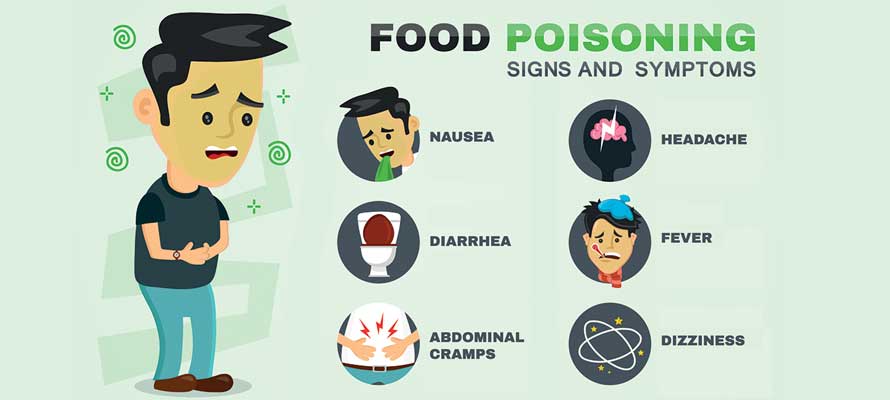*Note By Kashif J. Piracha– This article is about food poisoning. In this article, I cover the definition, causes, symptoms, diagnosis, and treatment of this condition. I also go over in detail the alarm symptoms, which require medical consultation. I also include information about modes of spread, preventative strategies to limit the spread of infection, and the specific population groups in which complications can occur.
Why knowing about Food Poisoning is essential?
The US Centers for Disease Control and Prevention (CDC)[1] estimates 1 in 6 Americans (48 million people) are affected by foodborne illness annually.
The estimates suggest 128,000 people are hospitalized and 3,000 die. It can affect patients individually, or it can affect a whole community of people in cases of an outbreak.
Fortunately, most people recover adequately. However, in a few cases, it can lead to significant complications, including severe dehydration.
This dehydration can progress to cause multi-organ failure and even death, so it is vital to be knowledgeable about it and take necessary precautions to protect against it.
What is Food Poisoning?
Food poisoning is a term used to describe the direct symptoms caused by the intake of contaminated foods that usually lead to nausea, vomiting, diarrhea – watery or bloody – along with abdominal pain and fever in select groups of patients.
Causes of Food Poisoning
The most common cause of food poisoning is due to ingestion of foods contaminated with a micro-organism.
These micro-organisms commonly consist of bacteria, viruses, and parasites.
- Bacteria – They produce disease in two different ways.
1) Firstly, they can produce a toxin that is already present in the food when it is consumed and leads to symptoms.Three common bacteria that do this include Bacillus cereus[2], Clostridium perfringens, and Staphylococcus aureus.
- a) Bacillus cereus causes most infections through eating contaminated fried rice. Symptoms usually include vomiting and diarrhea.
- b) Clostridium perfringens mostly causes outbreaks associated with inadequately heated or reheated meats, poultry, or gravy. It primarily causes a diarrheal illness with abdominal cramping. Vomiting and fever are uncommon.
- c) Staphylococcus aureus induced illness is usually due to contamination from a food handler. It mostly occurs through dairy, meat, eggs, and salads. It mainly causes nausea, vomiting, and abdominal cramps.
2) Secondly, the bacteria itself is consumed with food and is directly responsible for causing symptoms once inside the body.
Common examples include Salmonella, Campylobacter, Yersinia, Shigella, and Listeria.
- Salmonella is usually associated with the intake of poultry, eggs, and milk products. Symptoms include nausea, vomiting, fever, and diarrhea. Stool cultures can diagnose it
- Eating undercooked contaminated poultry causes Campylobacter infection. It mostly causes diarrhea, which can be watery or bloody. Stool cultures can make a diagnosis.
- Yersinia infection usually occurs through undercooked pork, unpasteurized milk, or contaminated water. Patients typically have diarrhea, and the organism can be isolated from stool cultures.
- Shigella usually spreads directly through person to person contact or contaminated food or water. It causes diarrhea with blood, mucus, and fever. Stool cultures can isolate this organism.
- Listeria causes diarrheal illness in specific populations like older adults, immunocompromised patients, and pregnant women.
- E. coli is a bacterial organism that can cause illness through multiple mechanisms. Some types of E. coli cause milder forms of diarrheal disease in developing countries called the Traveler’s diarrhea.In contrast, the ingestion of undercooked ground beef can transmit some more aggressive subtypes. They can cause invasive disease, which can be associated with bloody diarrhea and abdominal pain. Patients can develop significant complications, including kidney failure, that may require dialysis.
- Viruses like Norovirus, Rotavirus, Adenovirus and Hepatitis A
- Norovirus is a common source of community outbreaks. Patients present with watery diarrhea. Transmission occurs through contaminated foods.
- Rotavirus and Adenovirus usually cause infection in kids.
- Hepatitis A virus usually causes nausea, vomiting, fever, abdominal pain followed by jaundice. It can cause problems with liver function. Specific blood tests are needed to diagnose it.
- Parasites like Cryptosporidium parvum or Giardia Lamblia
- Cryptosporidium parvum is one of the most common parasitic causes of foodborne illness in the United States. It is widely present in cattle, and transmission can occur from an infected animal. However, another common source of spread is through drinking or swimming in contaminated water. It usually causes severe diarrhea.
- Giardia Lamblia can cause waterborne and foodborne illnesses. Symptoms include diarrhea, abdominal cramps, bloating, and foul-smelling stools.
How can Food Poisoning be prevented?
- Do not leave prepared food at room temperature for more than two hours.
- Try to refrigerate food within 2 hours of preparation. If the outside temperature is ≥ 90℉, refrigerate within 1 hour.
- While storing food, keep the refrigerator temperature ≤ 40℉.
- Do not drink raw or unpasteurized milk.
- Wash hands for at least 20 seconds before, during, or after handling any food.
- Always wash fresh fruits and vegetables under running water before eating.
- Thoroughly wash any pots, pans, knives, and cutting boards used in the handling of foods with hot, soapy water before reuse.
- Certain types of foods, like raw meat, poultry, and seafood, can cross-contaminate other foods at multiple steps in the process. These foods must be kept separate from other foods during assembly, storage, preparation, and consumption.
- Cook food thoroughly and confirm by using a food thermometer before consumption, especially meat, poultry, and seafood.
- Raw food may contain germs that need to be cooked to a specific temperature to ensure safety. You cannot merely tell by looking at the color or texture of food. The internal food temperature required for chicken and turkey is 165℉, pork 145℉, and ground beef 160℉. Incompletely cooked raw meat is a significant source of food poisoning.
- People manifesting symptoms of food poisoning like vomiting and diarrhea should take great precautions making sure they wash their hands properly before encountering other people.
What are the Symptoms of Food Poisoning?
There are a variety of ways food poisoning can manifest; therefore, it may be beneficial to look at the symptoms about specific organ systems separately.
- General: Malaise, fatigue, lethargy, decreased energy, weakness
- Neurologic: Lightheadedness, dizziness in mild cases. In severe cases, blurry vision, stiff neck, tingling in the arms or legs, even seizures can happen.
- Gastrointestinal: Nausea, vomiting, abdominal cramping, diarrhea that may be watery, may contain mucus or even frank blood.
- Infectious: High fever, chills
- Kidney: Low urine output, very dark concentrated urine
- Joints: Joint pain, even complete paralysis can also occur.

Food Poisoning Signs and Symptoms – Shutterstock Image
When do the Symptoms begin?
- There is a broad range of time over which symptoms can manifest.
- It can be as short as a few hours or as long as a few weeks.
- It depends upon the causative organism and the mode of toxicity.
- Majority cases have symptoms starting within 12 hours of ingestion.
How to know if you have Food Poisoning?
- Keep a high index of suspicion if you have an onset of symptoms after eating food that has been left at room temperature for an extended time or is raw or not properly cooked.
- Did you eat in a gathering where other people have also manifested symptoms like you?
- Did you have close contact with somebody who has had these symptoms recently, maybe somebody even in your household?
- Did you drink water from a lake, river or freshwater stream while hiking?
- Have you been on a cruise ship where there has been an outbreak?
- Have you recently traveled to a developing country and have eaten food from street vendors?
How to differentiate Food Poisoning from Stomach flu?
- It is difficult to distinguish between the two. One way we can differentiate is by the causative organisms.
- Viruses cause stomach flu, whereas viruses, bacteria, or parasites can cause food poisoning.
- Cases of food poisoning caused by viruses may appear similar to stomach flu.
- It is easier to make a distinction in cases of food poisoning by bacteria as they tend to cause invasion of the bowel wall, which can lead to bloody diarrhea along with mucus in stools.
- Another important distinction is the duration of symptoms. The usual stomach flu does not last longer than seven days. A more extended period of symptoms may indicate food poisoning with bacteria or parasites.
How is Food Poisoning Diagnosed?
- Pertinent history of food exposure. An essential component is an exposure to a contaminated source of food in a patient exhibiting relevant symptoms. It may be challenging to elicit, but if the exposure was in a communal setting where multiple people got sick after eating a particular food, it is usually easier to diagnose the source.
- White blood cell count in the blood should be checked. An elevation indicates infection.
- Bloody diarrhea can decrease red blood cell count in the blood. Severe cases may require transfusion.
- Some rare severe cases of food poisoning can even lead to a decrease in blood platelet counts.
- Kidney function testing should be performed to detect the degree of impairment depending upon how severe the dehydration is.
- Blood levels of sodium, potassium, calcium, magnesium, and phosphorus should be analyzed. These electrolytes are essential for several enzymatic processes in the body, and their depletion can have very detrimental effects. For example:
- Deficient sodium level can cause neurologic symptoms like irritability, confusion, alteration in mental status, even seizures.
- Deficient potassium levels can cause muscle weakness, cramps even muscle paralysis. They can also cause heart rhythm problems, even a cardiac arrest.
- Low calcium levels cause nerve tingling and numbness.
- We need phosphorus for energy-producing reactions in the body, and its depletion can lead to severe weakness and lethargy.
- Liver function testing is necessary to rule out viral hepatitis. Hepatitis A is commonly spread through the ingestion of contaminated food and water and can cause elevation of liver function tests.
- If the patient has diarrhea, a stool culture in the laboratory can identify the micro-organism in some cases.
- X Rays of the abdomen can be ordered to look at air-fluid levels in the bowels, which may indicate bowel obstruction.
- CT scan of the abdomen may be needed to look at the thickness of the bowel wall, development of abscesses, or a potential bowel rupture.
How does Food Poisoning spread?
- Inadequate handwashing after using the restroom can cause the spread of infection.
- The infected source can transmit the infection to household members.
- If a restaurant worker is a source, the infection can spread to multiple people and can potentially cause a community outbreak.
- Cooking food in inadequately washed utensils is another common source of infection.
What about Food Poisoning in specific populations?
- Kids are especially vulnerable to the effects of food poisoning. They can quickly become severely dehydrated and develop complications. Be vigilant to catch any worsening signs like lethargy, decreased activity, or low urine output.
- Pregnant women can also quickly develop complications associated with food poisoning. Dehydration can lead to kidney failure or low blood pressure in mom and can adversely affect the well-being of the baby.
- Immunosuppressed patients can develop overwhelming bacterial infections from food poisoning. Patients who are taking immune suppressive medications like transplant recipients, patients on chemotherapy for cancer treatment, or patients with HIV are susceptible because their immune systems cannot mount a strong response. They need aggressive management, or they can quickly deteriorate.
- Elderly patients, especially the ones living in nursing homes or such facilities, are prone to severe dehydration from food poisoning due to close contact with other residents and transmission of infection. They also have difficulty asking for water, which can make matters worse.
How is Food Poisoning Treated?
The treatment of food poisoning is multi-faceted. The following are the essential components.
- Symptom Management
- Rehydration
- Diet
- Over the counter medications
- Prescription medications
- Advance measures like dialysis
- Symptom Management – Patients need treatment for their symptoms. Medications for nausea, fever, vomiting, and diarrhea are all required to give patients adequate relief. Most of these medications are available over the counter, but some may need a doctor’s prescription.
- Rehydration – Many patients with food poisoning get very dehydrated from nausea, vomiting, and diarrhea. Such patients can develop complications like low blood pressure or kidney failure. They need aggressive rehydration. The rehydration can take the shape of intravenous fluids through a drip in a hospital setting, or if the vomiting is not too severe, the patient can use an oral rehydrating solution at home. Anybody fluids lost must be replaced to keep the balance.
- Diet – In cases of food poisoning, it is vital to eat a soft, low fat easily digestible diet in small portions. Boiled starches and cereals like potatoes, rice, and wheat with salt are indicated in patients with watery diarrhea. Also, crackers, bananas, soup, and boiled vegetables may also be consumed. Fried foods and foods with high-fat content should be avoided until bowel function completely normalizes. Avoid milk and dairy products. Diarrhea leads to lactose intolerance, which can persist for several weeks even after symptoms have resolved.
- Antibiotics – In several cases of bacterial infections, appropriate antibiotic therapy is necessary to prevent the proliferation and multiplication of the bacteria responsible. If proper antibiotic treatment is not given, patients can develop sepsis, which is a life-threatening illness.
- Advanced measures like dialysis – In certain severe cases of food poisoning, kidney function can shut down. Patients may require dialysis.
How to know when to seek Medical Consultation?
Many cases of food poisoning are very mild and can just be managed with supportive care at home.
Such measures include adequate rehydration, gentle diet, symptom management with over the counter medications, proper handwashing, and rest.
However, you need to watch out for alarm symptoms. If such symptoms arise, seek medical consultation with a doctor.
Some alarm symptoms are:
- High fever lasting more than a few days not resolving with over the counter medications.
- Severe abdominal pain and cramping with bloody diarrhea.
- Severe neurologic symptoms like neck stiffness, alteration in mentation, and seizures.
- Any time symptoms last more than seven days.
- Severe muscle weakness or paralysis.
Where to look for more information?
- The Centers for Disease Control (CDC) has extensive resources under Foodborne Illnesses, which encompass specific features of food poisoning from several different organisms. It is an excellent resource for you to use if you start having symptoms.
- Watch out for any announcements in digital or print media about FDA issuing recalls of contaminated food products or about an outbreak going on in the community so you can take necessary precautions.
Conclusion
- Food poisoning is an illness with a broad spectrum.
- Most cases are mild and self-limited and can be treated with supportive care at home.
- Some cases are more severe and require medical consultation and even hospitalization.
- Always look out for alarming symptoms and seek appropriate help early.
- When traveling, make sure the food you consume comes from reliable sources and has been adequately cooked and washed before consumption.
- Symptoms can quickly deteriorate in vulnerable populations.
- Do not be lulled into a false sense of safety that all cases of foodborne illnesses are mild.
- If you develop symptoms, make sure to wash your hands adequately before coming into contact with other people to prevent the spread of infection.
- Keep an eye out for announcements in the media regarding a possible outbreak in the community.
Sources
Health Insiders relies on peer-reviewed studies, academic research institutions, and medical associations. We avoid using tertiary references. You can learn more about how we ensure our content is accurate and current by reading our editorial policy.
[1] Foodborne Germs and Illnesses /ptr.5017. Epub 2013 Jun 11. PMID: 23754792.
[2] Duport C, Jobin M, Schmitt P. Adaptation in Bacillus cereus: From Stress to Disease. Front Microbiol. 2016 Oct 4;7:1550. doi: 10.3389/fmicb.2016.01550. PMID: 27757102; PMCID: PMC5047918.







 This article changed my life!
This article changed my life! This article was informative.
This article was informative. I have a medical question.
I have a medical question. Ask a Question
Ask a Question
 This article contains incorrect information.
This article contains incorrect information. This article doesn’t have the information I’m looking for.
This article doesn’t have the information I’m looking for.